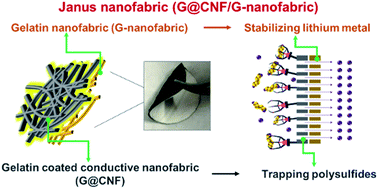当前位置:
X-MOL 学术
›
J. Mater. Chem. A
›
论文详情
Our official English website, www.x-mol.net, welcomes your
feedback! (Note: you will need to create a separate account there.)
A Janus protein-based nanofabric for trapping polysulfides and stabilizing lithium metal in lithium–sulfur batteries
Journal of Materials Chemistry A ( IF 10.7 ) Pub Date : 2020/03/23 , DOI: 10.1039/d0ta01989e Min Chen 1, 2, 3, 4, 5 , Zhiping Chen 5, 6, 7, 8 , Xuewei Fu 1, 2, 3, 4 , Wei-Hong Zhong 1, 2, 3, 4
Journal of Materials Chemistry A ( IF 10.7 ) Pub Date : 2020/03/23 , DOI: 10.1039/d0ta01989e Min Chen 1, 2, 3, 4, 5 , Zhiping Chen 5, 6, 7, 8 , Xuewei Fu 1, 2, 3, 4 , Wei-Hong Zhong 1, 2, 3, 4
Affiliation

|
The shuttling of polysulfides and uncontrollable growth of lithium dendrites remain the most critical obstacles deteriorating the performance and safety of lithium–sulfur batteries. The separator plays a key role in molecule diffusion and ion transport kinetics; thus, endowing the separator with functions to address the two abovementioned issues is an urgent need. Herein, a protein-based, low-resistance Janus nanofabric is designed and fabricated for simultaneously trapping polysulfides and stabilizing lithium metal. The Janus nanofabric is achieved via combining two functional nanofabric layers, a gelatin-coated conductive nanofabric (G@CNF) as a polysulfide-blocking layer and a gelatin nanofabric (G-nanofabric) as an ion-regulating layer, into a heterostructure. The gelatin coating of G@CNF effectively enhances the polysulfide-trapping ability owing to strong gelatin–polysulfide interactions. The G-nanofabric with exceptional wettability, high ionic conductivity (4.9 × 10−3 S cm−1) and a high lithium-ion transference number (0.73) helps stabilize ion deposition and thus suppresses the growth of lithium dendrites. As a result, a Li/Li symmetric cell with the G-nanofabric delivers ultra-long cycle life over 1000 h with very stable performance. Benefiting from the synergistic effect of the two functional layers of the Janus nanofabric, the resulting Li–S batteries demonstrate excellent capacity, rate performance and cycling stability (e.g. initial discharge capacity of 890 mA h g−1 with a decay rate of 0.117% up to 300 cycles at 0.5 A g−1).
中文翻译:

一种基于Janus蛋白的纳米织物,用于捕获锂硫电池中的多硫化物并稳定锂金属
多硫化物的穿梭运动和锂树枝状晶体的失控增长仍然是使锂硫电池性能和安全性恶化的最主要障碍。隔板在分子扩散和离子迁移动力学中起着关键作用。因此,迫切需要使隔板具有解决上述两个问题的功能。本文中,设计并制造了一种基于蛋白质的低电阻Janus纳米织物,用于同时捕获多硫化物和稳定锂金属。Janus纳米织物是通过将两个功能纳米纤维层,一个作为多硫化物阻隔层的明胶涂层导电纳米纤维(G @ CNF)和一个作为离子调节层的明胶纳米纤维(G-纳米纤维)组合成异质结构。由于强的明胶-多硫化物相互作用,G @ CNF的明胶涂层有效地增强了多硫化物的捕获能力。G纳米织物具有出色的润湿性,高离子电导率(4.9×10 -3 S cm -1)和高的锂离子转移数(0.73)有助于稳定离子沉积,从而抑制锂树枝状晶体的生长。因此,具有G纳米织物的Li / Li对称电池可提供超过1000小时的超长循环寿命,并具有非常稳定的性能。得益于Janus纳米织物的两个功能层的协同效应,所得的Li–S电池具有出色的容量,倍率性能和循环稳定性(例如,初始放电容量为890 mA hg -1,衰减率最高为0.117%在0.5 A g -1时300次循环。
更新日期:2020-04-15
中文翻译:

一种基于Janus蛋白的纳米织物,用于捕获锂硫电池中的多硫化物并稳定锂金属
多硫化物的穿梭运动和锂树枝状晶体的失控增长仍然是使锂硫电池性能和安全性恶化的最主要障碍。隔板在分子扩散和离子迁移动力学中起着关键作用。因此,迫切需要使隔板具有解决上述两个问题的功能。本文中,设计并制造了一种基于蛋白质的低电阻Janus纳米织物,用于同时捕获多硫化物和稳定锂金属。Janus纳米织物是通过将两个功能纳米纤维层,一个作为多硫化物阻隔层的明胶涂层导电纳米纤维(G @ CNF)和一个作为离子调节层的明胶纳米纤维(G-纳米纤维)组合成异质结构。由于强的明胶-多硫化物相互作用,G @ CNF的明胶涂层有效地增强了多硫化物的捕获能力。G纳米织物具有出色的润湿性,高离子电导率(4.9×10 -3 S cm -1)和高的锂离子转移数(0.73)有助于稳定离子沉积,从而抑制锂树枝状晶体的生长。因此,具有G纳米织物的Li / Li对称电池可提供超过1000小时的超长循环寿命,并具有非常稳定的性能。得益于Janus纳米织物的两个功能层的协同效应,所得的Li–S电池具有出色的容量,倍率性能和循环稳定性(例如,初始放电容量为890 mA hg -1,衰减率最高为0.117%在0.5 A g -1时300次循环。











































 京公网安备 11010802027423号
京公网安备 11010802027423号